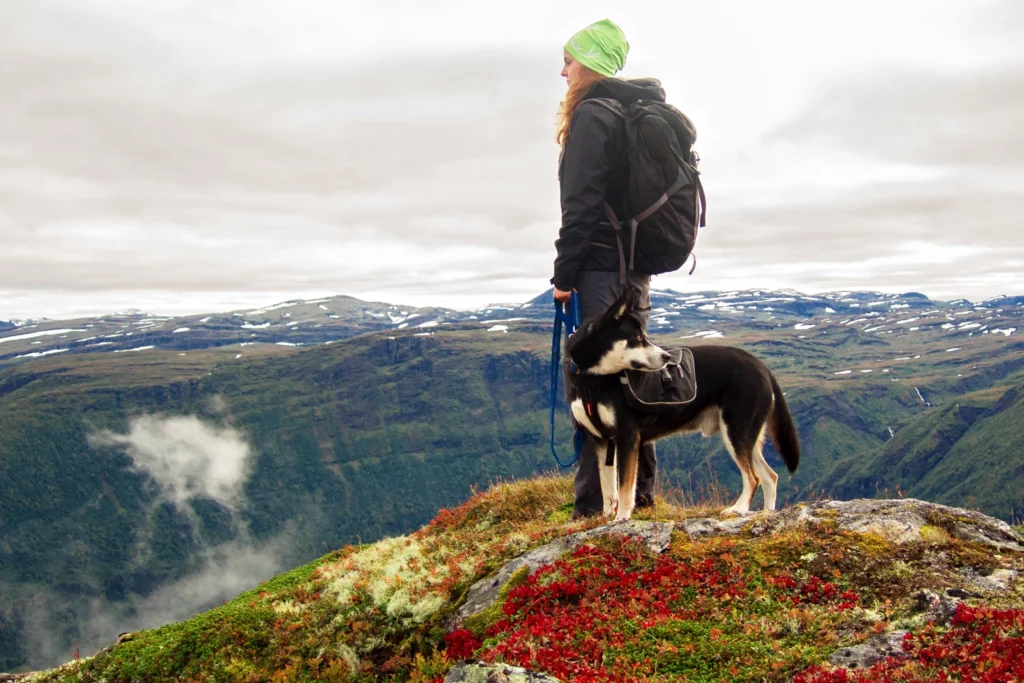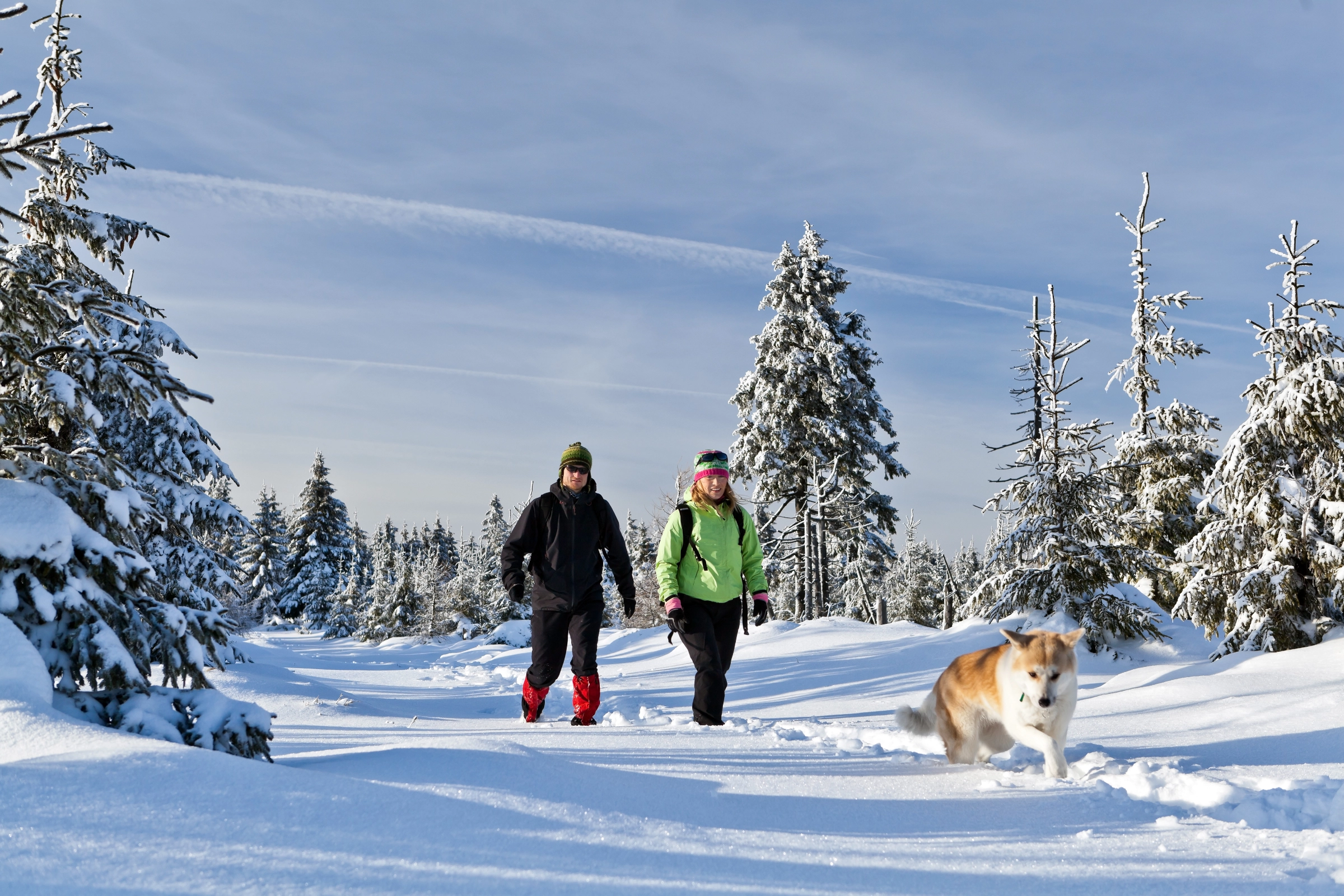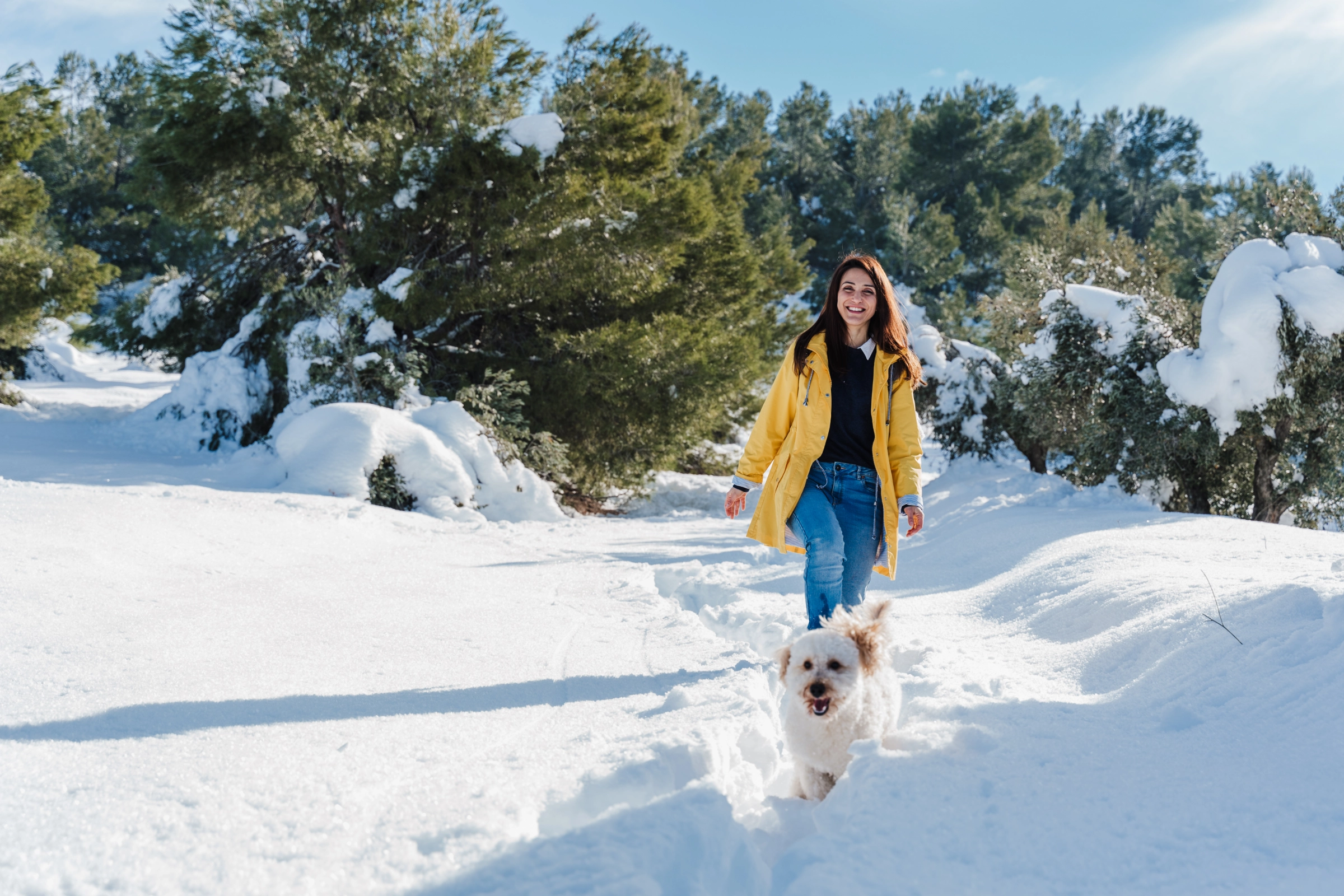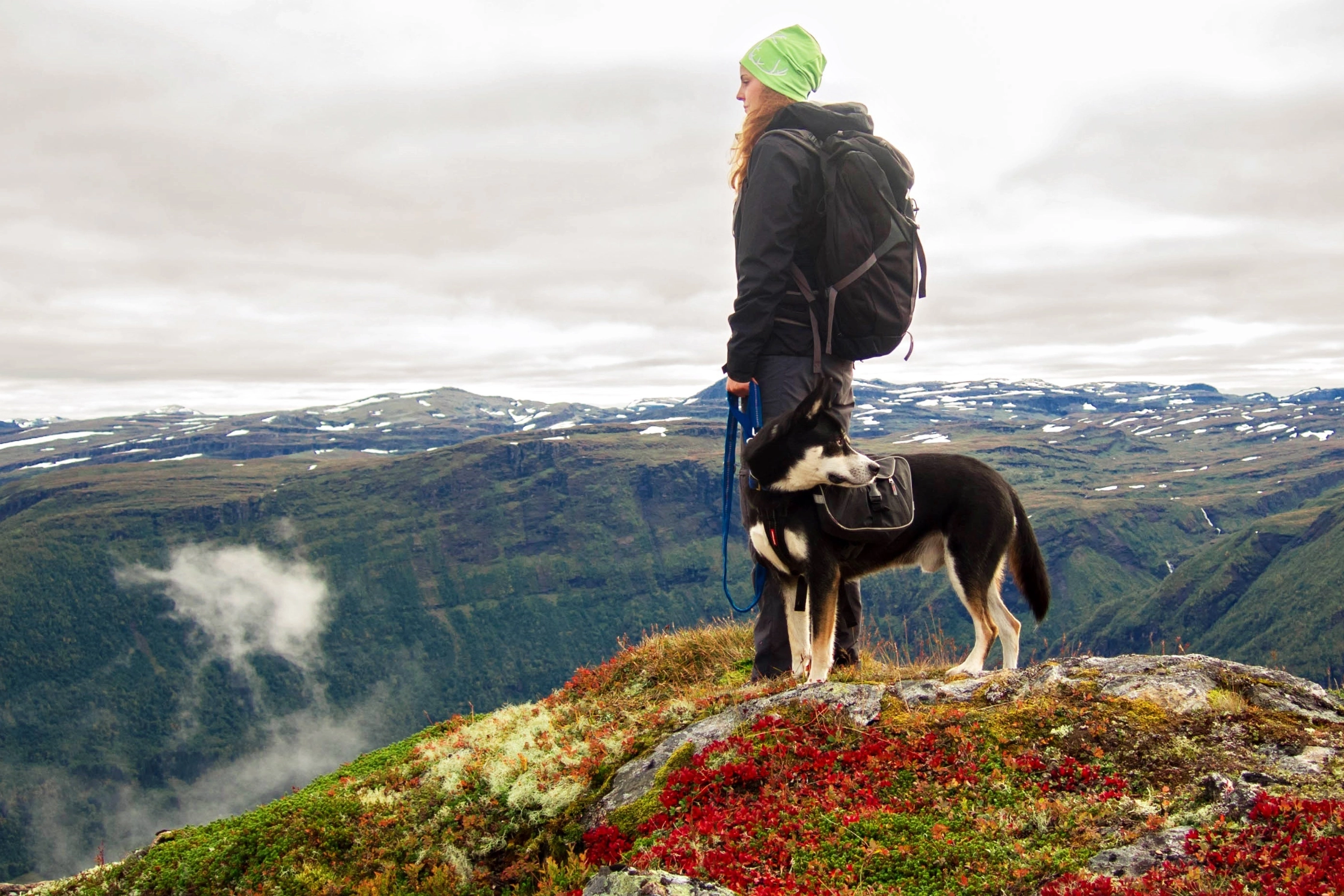This post may contain ads and affiliate links and we may earn a small commission when you click on the links at no additional cost to you. As an Amazon Affiliate, we earn from qualifying purchases. You can read our full disclaimer here.
Winter Hiking with Dogs: Best Gear, Training, and Safety Tips

Winter hiking with dogs can be an enriching experience, offering not just exercise but also a unique bonding opportunity for both of you.
But before you rush to put on those hiking boots and strap a leash on your pup, there are some essential things you need to consider.
From the right kind of gear to suitable breeds that love the chill, and from basic training to first aid essentials, there’s a lot to cover to ensure you both have a safe and enjoyable outing.
Why Winter Hiking with Dogs?

So, what’s the big deal about winter hiking with dogs?
First off, it’s refreshing. The crisp air invigorates the senses. Plus, the snow-covered landscape offers a magical backdrop.
For your dog, it’s a chance to explore new scents and sights. Exercise is a big plus too. Winter hikes help keep both you and your pup fit during those chilly months.
Health Benefits
Let’s talk benefits. Exercise releases endorphins. This is true for humans and dogs. Regular physical activity can improve your dog’s overall health.
Think better weight management, improved cardiovascular health, and enhanced mood. For you, the benefits are similar. Plus, it’s a great way to combat those winter blues.
- Improved cardiovascular health
- Weight management
- Stress relief
- Enhanced mood
Mental Engagement
But wait, there’s more. Winter hikes provide mental stimulation for your dog. The varied terrains challenge them.
They get to problem-solve as they navigate through snow and ice. Sniffing around in a new environment keeps their minds sharp. And let’s face it, a mentally engaged dog is a happy dog.
- Problem-solving skills
- Mental stimulation
- Increased happiness
Bonding Time in Winter Hiking with Dogs
Lastly, let’s talk bonding. Spending quality time outdoors strengthens your relationship with your pup. It builds trust. Shared experiences, especially challenging ones, create lasting bonds.
So each time you negotiate a slippery slope together or enjoy a quiet moment watching the snowfall, you’re not just hiking. You’re building a lifelong friendship.
- Stronger bond with your dog
- Enhanced trust
- Shared experiences
That’s a pretty compelling list of reasons, right? Winter hiking with your dog isn’t just about getting out of the house. It’s about improving the quality of life for both you and your furry friend.
Gearing Up for Winter Hiking with Dogs
Ready to step out into the frosty wilderness? Wait up! You wouldn’t head out in the cold without proper attire, and neither should your dog. It’s time to think about gear.
Getting the right equipment can make all the difference in your winter hiking experience.
Basics First
Start with the essentials. Your dog will need a sturdy leash and collar. Opt for a leash that gives you good control. Retractable leashes are a no-go.
They’re not great for maintaining control on unpredictable terrains. A collar with an ID tag is also crucial. Make sure your contact details are up to date.
- Sturdy leash
- Collar with ID tag
- Doggy backpack for carrying supplies
How about a doggy backpack? Yes, your pup can carry his own supplies. Make sure it’s a comfortable fit and doesn’t weigh him down. Test it out on shorter walks first.
With a breathable, padded underside and adaptive elastic straps, it promises comfort, durability, and a hint of reflective safety. Perfect for those energetic winter trailblazers!
Designed for large pups, it’s lightweight at 21oz and comes with leash clips. Perfect for frosty treks with your fur-buddy!
Cold Weather Specifics
Now, let’s talk winter gear. If your dog has short hair, consider a doggy sweater or jacket. It provides that extra layer of warmth.
Don’t forget about those paws. Ice and salt on the roads can be harsh on your dog’s feet. Booties can provide protection and also offer extra grip on slippery surfaces.
- Doggy sweater or jacket
- Paw protectors or booties
- Heated water bowl
A heated water bowl isn’t a must, but it’s a good-to-have item. It ensures that the water doesn’t freeze over during your hike, making sure your dog stays hydrated.
Winter Hiking with Dogs: Breeds Built for the Snow
So, you’re ready to embrace the icy trails, but is your furry companion? Not all dogs are built for snowy escapades, and it’s essential to understand this before lacing up your hiking boots.
Let’s explore breeds that naturally excel in wintry conditions, as well as those that can adapt with a little help.
Natural Snow Lovers
First up are the champions of winter—the breeds that seem to have snow in their DNA.
- Siberian Huskies: These dogs were bred to pull sleds over long distances in Arctic conditions. They have thick, double coats for insulation and wide paws for excellent snow traction.
- Alaskan Malamutes: Similar to Huskies but larger, Malamutes were also designed for Arctic living. Their dense coat and strong build make them ideal for long hikes in wintry weather.
- Bernese Mountain Dogs: Native to the cold Swiss Alps, these dogs have a thick, long coat and a sturdy build. They’re great for short to moderate hikes in the snow, and their friendly demeanor makes them excellent companions.
- Samoyeds: Known for their fluffy white coats, Samoyeds are exceptionally good in the cold. Originating from Siberia, they were used for herding and pulling sleds. Their coat provides excellent insulation, and they have a high activity level ideal for hiking.
Good for Moderate Cold
Some breeds may not have snowy origins but can still be good hiking buddies in moderate cold.
- Golden Retrievers: These dogs have a water-resistant outer coat and good stamina but might need a doggy sweater for added warmth.
- Labradors: Highly adaptable, Labradors can handle moderate cold thanks to their double coat. However, their paws are not as padded as some winter breeds, so booties could be beneficial.
- German Shepherds: A versatile breed, German Shepherds have a thick double coat that provides good insulation. They also have high energy levels, making them great for active hikes.
- Border Collies: These dogs are energetic and smart, with a thick double coat that offers some protection against the cold. Keep in mind, however, that their smaller size and lighter build might require some added insulation like a coat or sweater.
Have a Golden? Read our post about Golden Retriever Feathers!
Traits to Consider
Not sure if your breed fits into these categories? Look for these traits that make for a good winter hiking companion:
- A thick or double coat for insulation
- High energy levels for endurance
- Strong paws for traversing snow and ice
Remember, even if your dog is built for winter, that doesn’t mean you can skimp on preparation or gear. Always ensure your furry friend is as well-equipped for the cold as you are.

Winter Hiking with Dogs Training for the Trails
You’ve got the gear, and you’ve evaluated your dog’s breed suitability for winter hiking. What’s next? Training, of course! Winter trails offer unique challenges that require both you and your pup to be well-prepared.
Basic Commands
Before hitting the trails, your dog should be comfortable following basic commands like ‘sit,’ ‘stay,’ and ‘come.’ These commands are your safety net. They help you maintain control in unexpected situations.
For instance, the ‘stay’ command can be crucial if you need to momentarily assess a potentially risky path ahead.
Trail Behavior
Sharing the trail is a must, whether it’s with other hikers, animals, or even vehicles. Teaching your dog to be well-behaved around others makes the experience pleasant for everyone involved.
Start by socializing your dog in controlled environments like a dog park before venturing out on hikes.
Stamina Building
Endurance is essential for long winter hikes. Both you and your dog need to be physically prepared. Start slow, with shorter hikes, and gradually build up the distance.
Monitor your dog for signs of fatigue or discomfort, especially in the cold. Keep in mind that carrying a doggy backpack adds extra weight, so consider that when training.
Navigating Difficult Terrains
Snow and ice can make terrains slippery and challenging. Train your dog to walk steadily on different surfaces.
If you’re planning on hiking in particularly rugged areas, you might also want to teach your dog to navigate obstacles like rocks and streams. Treats and positive reinforcement work wonders here.
Practice, Practice, Practice
The key to a successful winter hike is repetition. The more you train, the more natural it becomes for both you and your dog.
Try varying your practice terrains and weather conditions to prepare for any situation you might encounter.
Proper training can go a long way in ensuring you and your dog enjoy winter hiking safely and responsibly.
Remember, the aim is to have fun, so keep training sessions upbeat and reward good behavior generously.
First Aid and Safety: Protection for Winter Hiking with Dogs
Now that you and your pup are trained and eager to embark on your winter hiking adventure, let’s shift focus to first aid and safety.
Accidents and unexpected issues can arise even on the most familiar trails, so it’s crucial to be prepared.
First Aid Kit Essentials
A specialized doggie first aid kit can be a lifesaver. Your kit should include:
- Antiseptic wipes or solution
- Sterile gauze pads and adhesive tape
- Tweezers for tick removal
- A small pair of scissors
- A pet-safe pain reliever (consult your vet)
- Emergency contact numbers, including the nearest vet
- Doggy paw balm for cracked or sore pads
- Extra dog food and water
Having these supplies on hand can help you address minor injuries or discomforts immediately, giving you time to seek professional help if needed.
The kit features a self-adhering bandage designed to not stick to fur, making injury management stress-free. Also included is a pet first aid manual, sterile bandage materials, common medications, and waterproof DryFlex bags for durability.
Recognize the Signs
Being attentive to your dog’s behavior is key. If your dog starts limping, acting lethargic, or showing signs of distress, it’s time to evaluate the situation.
Some common issues you might encounter are paw pad injuries, hypothermia, and frostbite.
What to Do in Emergencies when Winter Hiking with Dogs
For minor cuts or paw injuries, clean the area with antiseptic and apply a gauze pad. If you suspect frostbite or hypothermia—indicated by extreme shivering, lethargy, or skin turning pale, grey, or bluish—wrap your dog in a warm blanket and seek immediate veterinary assistance.
Wildlife Interactions
Winter hikes can lead to encounters with wildlife. Always keep your dog on a leash and maintain a safe distance from wild animals.
If your dog is trained to follow the ‘leave it’ command, now’s the time to use it. Some areas may have specific rules about interacting with wildlife, so make sure you’re familiar with local guidelines.
Safety should be your top priority when winter hiking with your dog.
A well-stocked first aid kit, attentiveness to your dog’s condition, and respect for wildlife all contribute to a successful and enjoyable winter hiking experience.
Wrapping It Up: Enjoying Winter Hiking with Dogs

You’ve covered the bases—gear, breed suitability, training, and safety. Now, what’s left is the most enjoyable part: hitting those snow-covered trails with your four-legged friend.
Winter hiking with dogs can be one of the most rewarding experiences for both of you, provided you’ve taken the right precautions.
Choose the Right Trail
Not all hiking trails are suitable for winter excursions. Pick a trail that aligns with both your hiking skills and your dog’s physical abilities.
Consider factors like distance, elevation gain, and trail conditions. Research beforehand, read reviews from other dog owners, and maybe even do a solo recon mission to assess the trail’s suitability.
Hike at Your Dog’s Pace
Remember, this outing is as much about your dog as it is about you. Let them explore, sniff around, and enjoy the environment.
If your dog is new to hiking, or if it’s a particularly cold day, consider taking frequent short breaks to check on your dog’s well-being.
Capture the Moments
Don’t forget your camera or smartphone. Winter hikes offer stunning photo ops, making for memorable snapshots.
Capture the joy on your dog’s face as they romp through the snow, or the peaceful serenity of a snow-covered forest. These are the moments you’ll cherish.
Post-Hike Rituals
Once you’re back, it’s important to check your dog for any ticks, cuts, or ice balls that may have formed between their paw pads.
A post-hike warm bath can do wonders, especially for dogs with long fur that may have collected snow or ice.
Plan the Next Adventure
Loved your winter hiking experience? There’s no reason to stop at just one. Start planning your next adventure.
Maybe pick a different trail, or go back to the same one to enjoy its familiar comfort. The world is your snowy oyster!
Winter hiking with your dog is about more than just exercise. It’s about the joy of shared experiences and the serenity that comes from being close to nature.
It’s about making the most of the season and creating wonderful memories with your furry friend.
-

Coffee Mug – In Dog Coffees I’ve Only Had One
$11.95 – $14.95 Select options This product has multiple variants. The options may be chosen on the product page



